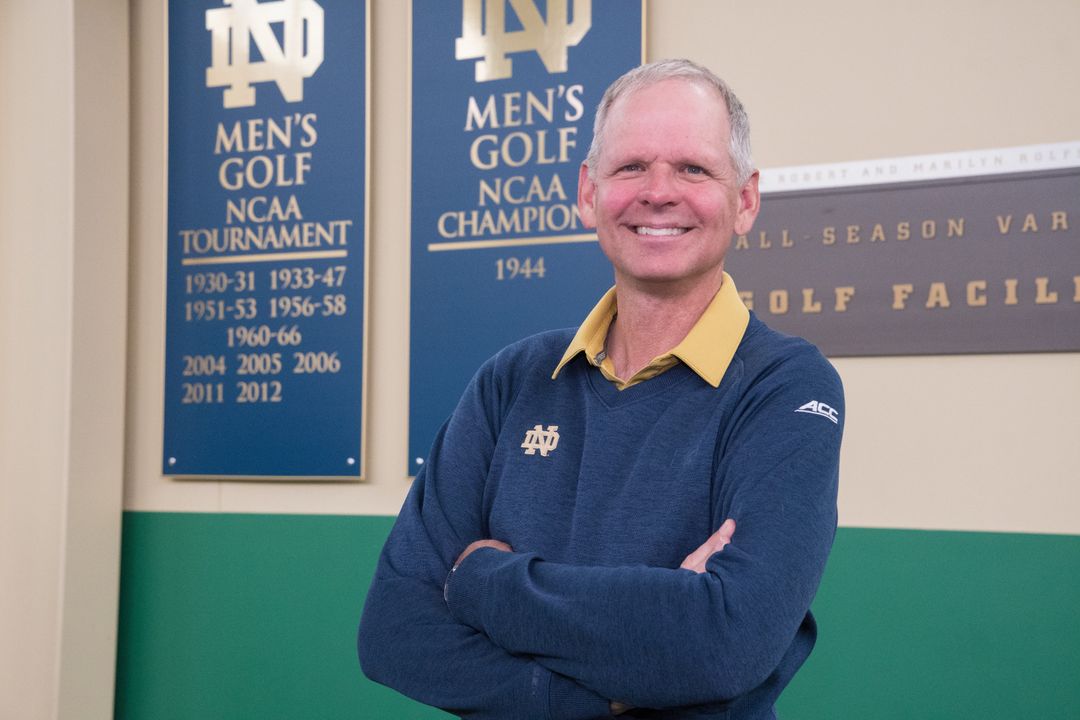April 15, 2017
By John Heisler
University of Notre Dame assistant men’s golf coach Scott Gump found himself riveted to every moment of the Masters golf telecast last weekend.
“I watched every second of it,” he says. “We had a couple of days off over the weekend-and for golfers it’s like Christmas morning.
“I’m such a golf geek, and I just love the stories. Golf is all about stories, and there are so many at the Masters. What a place.”
Gump-whose own pro golf career included two starts in Augusta–felt a particular connection as he watched Sergio Garcia win his first major.
“I played in 2000, and they have a little cocktail party for the first-time pros,” says Gump. “So I was there (after previously playing at the Masters as an amateur in 1988) and so was Sergio because it was his first year playing as a pro (he played the previous year and finished as low amateur).”
Check the final leaderboard that year and Gump’s name is one of two tied for 46th place at 296 (75-70-78-73). Among the six players a shot ahead at 295 was Garcia.
Gump, who also played four times in the U.S. Open, three times at the PGA Championship and once at the British Open, brings all sorts of his own stories to his fifth season in 2017 as Jim Kubinski’s assistant coach with the Irish.
He played with Rocco Mediate at Pebble Beach in 2000 when Tiger Woods won the U.S. Open by a record 15 shots.
“In 2000 when I made the cut at the Masters I played with Colin Montgomerie in the third round. I shot 78 when the wind came up and I spun a wedge back into the water on 13.
“The experience being there, the history . . . I enjoyed playing even when I wasn’t playing well. I just love golf in general.”
The Masters produces a hardcover, full-color book (with a green cover, of course) as a recap of each tournament, and the 2000 version Gump received lists his name in a box on the pages that recap Friday action when he shot his 70.
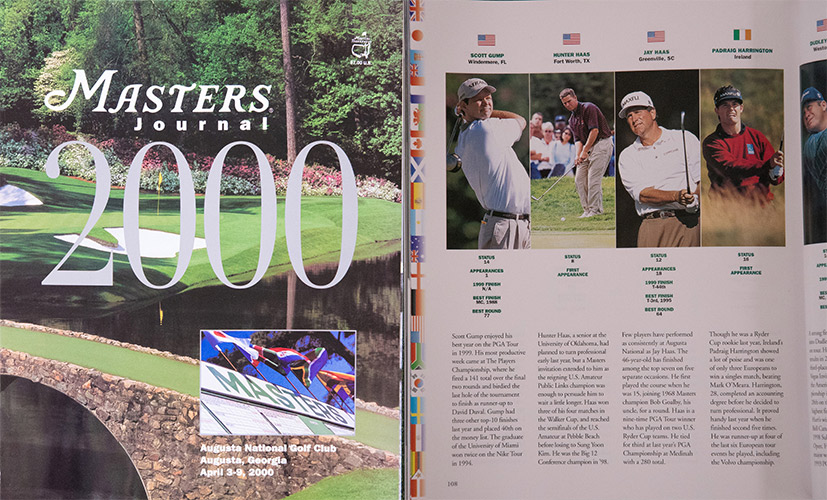 Scott Gump’s qualification for the 2000 Masters earned him a featured spot in the Masters Journal, the official program. – Mike Bennett/Lighthouse Imaging
Scott Gump’s qualification for the 2000 Masters earned him a featured spot in the Masters Journal, the official program. – Mike Bennett/Lighthouse Imaging
First there’s Tiger Woods leading in driving distance at 315, Tom Watson on top in driving accuracy at 13 of 14 fairways, four golfers hitting 16 greens in regulation–and then Gump with the best figure in total putts at 23.
“I show this to them (current Irish players) to prove I’m not just some old guy,” he says.
“My first time at Augusta (1988) was because I finished in the final four the year before at the U.S. Amateur (he was also medalist among 312 golfers after two rounds),” says Gump. “When I qualified in 2000 you had to finish in the top 40 on the money list and I finished exactly 40th (earning $954,742 based on four top-10 finishes) in 1999.
“That’s what I tell our guys – all the way from your first youth event to the Ryder Cup, there are lists for qualifications. Our guys this weekend are grinding it to qualify for our team for the ACCs (the Atlantic Coast Conference Championship next weekend in Clinton, South Carolina). It’s no different when you get to that (PGA) level. It keeps pushing you-you have to embrace that in golf. You have to keep chasing those lists, and there are carrots.”
Gump began by helping his Brevard (Florida) Community College golf team to a national junior college championship. He transferred to Miami and started on a Hurricane team his junior year where all five players made it on the PGA Tour for at least one year.
“No other college team that I know of had that happen,” says Gump.
He had planned to turn pro after graduation (he owns a business administration degree) and playing in the U.S. Amateur, but when his efforts at that summer event earned him the Masters invitation for the following April he found himself with time to kill.
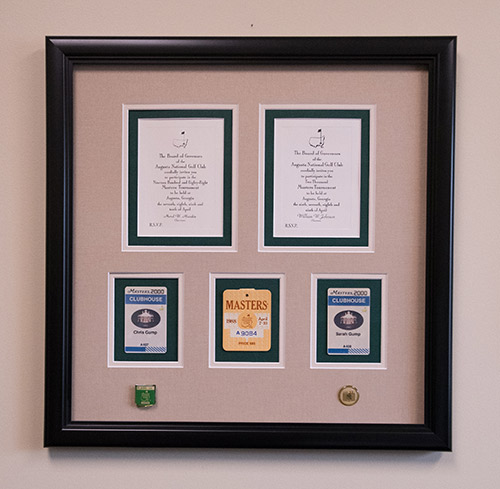 Scott Gump’s two appearances at theMasters produced memories for a lifetime. – Mike Bennett/Lighthouse Imaging
Scott Gump’s two appearances at theMasters produced memories for a lifetime. – Mike Bennett/Lighthouse Imaging
“I went back to the Miami-Florida football game that fall and and that’s when I met (his future wife) Christine.
“Meanwhile I was finding some tournaments to play in and I won four events, went twice to Mexico, won the Middle Atlantic Amateur and won a tournament in Tampa. So I’d come to Miami to visit Chris and see my old golf coach, and every time I came I’d bring home another trophy. I even caddied on the PGA Tour-I had a buddy that made it through tour school.
“Chris came to Augusta in 1988 and no one keeps score in practice rounds, but I shot 68 playing with Gary Player. I thought, ‘This is great.’ But the course changes from Tuesday to Friday. I started trying too hard in the par-three tournament on Wednesday – I hit a putt 10 feet past the hole. I should have laughed it off, but it shook my confidence and I scored poorly. I started three-putting-I just couldn’t get my putting down because they’d changed the greens.
“I stayed at the Crows Nest (on top of the Augusta National Clubhouse) and Chris stayed in the family motor home. On Sunday when Sandy Lyle won we had the best seats in the house in front of the clubhouse TV. When we’re leaving the Augusta staff people are saying, ‘See you next year,’ and we think that’s great-but it took me some years to get back.”
“Chris graduated with an accounting degree, and we decided to do the pro golf thing. She caddied for me in the summer on the mini-tours and made it through tour school in 1990. We got married in May that year and did not come home until October.
“She caddied for me, she knew me well and she knew me under stress. She was the rock, she was always there, she knew what I needed.”
Gump played more than 500 total events on the PGA and Nationwide tours combined.
“Of the first 300 Chris probably missed only five before our daughter (Sarah) was born,” he says. “You never had guaranteed employment for more than one year, but we said, ‘Let’s see how this golf thing goes.’
“I finished 80th (on the money list) that first year. So you played okay, survived and made some money. Twenty years later we’d been to Morocco, Australia, New Zealand, Japan – and I’d played in 45 of the 50 states. As a family we’ve seen the world together and we were very blessed. We loved it.”
A touring professional golfer for more 24 years, Gump earned his PGA Tour card during the 1991 season after finishing third at the Tour’s Q School tournament. Following an 18-year stint on both the PGA and Web.com tours, with more than $2.7 million in career earnings, Gump holds lifetime membership status for making more than 150 cuts in 329 career PGA starts.
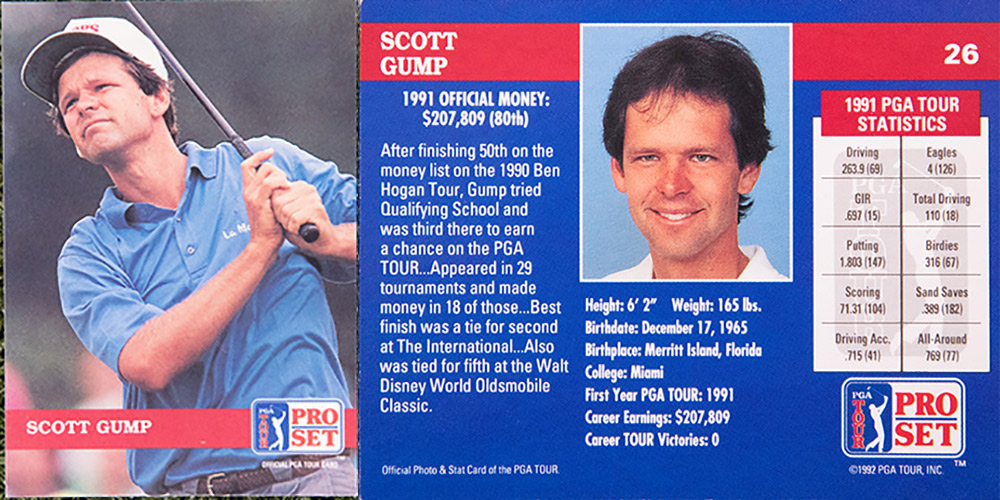 Mike Bennett/Lighthouse Imaging
Mike Bennett/Lighthouse Imaging
Gump was a three-time champion on the Web.com Tour, winning his first two career tournaments in 1994. He fired a 19-under par 269 (67-67-68-67) to win the Monterrey Open and followed with a victory later that season at the Greater Greensville Classic. Gump’s $161,035 earned ranked second on the 1994 Web.com Tour money list.
More than 10 years after his last victory at Greensville, Gump broke through once more on the Web.com Tour by claiming the Albertsons Boise Open in September of 2004.
The Merritt Island, Florida, native in 1991, his first year on tour, took a first-day lead with a 65 at the Kemper Open. In 1998 he shot a course-record 62 in the second round of the Greater Hartford Open. A year later he finished second at The Players Championship to David Duval who with the victory passed Woods to become the top-ranked player in the world.
He also finished second at the 1998 Quad City Classic and the 1991 International-in addition to the three Nationwide Tour victories. He’s particularly proud of that victory at the Boise Open.
“To come back and find a way to win at Boise–it’s kind of a behind-the-scenes event, not a PGA Tour event,” he says. “But to stick with it and still play and come back and win, it was great self-satisfaction.”
People still ask Gump why he doesn’t play Senior Tour events.
“From age 15 to 2009 when I was 43 or 44 – that’s almost 30 years where I woke up every day knowing I have to perform and get the job done or I won’t be able to stay in the game,” he says. “That’s a hard thing to explain. I see these NBA guys who do their craft well for maybe 10 years. I won a national championship in junior college to ranking sixth as an amateur to winning three events. So, you know what? I’m okay–30 years was enough.”
Gump got the itch for collegiate coaching through his friendship with longtime PGA veteran John Inman, who spent 13 years as head men’s golf coach at the University of North Carolina.
“John won the 1984 NCAA title (at North Carolina) and eventually became head coach at UNC in 1998,” says Gump. “Even when I was playing I would go visit him. We traveled a lot together, and our wives were friends. I could always tell in his voice that he loved it.”
Gump was in Orlando after taking a job with the Gary Gilchrist Golf Academy at the Mission Inn Golf and Tennis Resort. But he knew he wanted to get into college coaching.
“The problem is that there isn’t much turnover in college jobs,” he says. “There are more jobs at a 7-Eleven in South Bend than there are college golf jobs in the entire state of Florida. When this job opened up, it looked like a good fit and I went through the process and am very blessed to be here.
“I had played a lot at a high level, but I did not come in with much coaching experience so I was a little unique. When I saw what Notre Dame has-the facilities, the academic side, the tradition-it’s everything. This place has created amazing alumni connections considering it’s not a huge school. And we thought his would be a great place to raise our daughter (Sarah is a junior at Penn High School).”
Gump always considered himself a student of the game-and he felt that became his greatest asset.
“I was mindful, constantly observing. What can I steal from him? I had a lot of tools in my tool chest, and I prided myself on being able to adapt to the moment. Even when I was in college I would stop practicing to go watch other guys. What’s he doing? What’s he working on? I was constantly observing and then deciding, ‘I want to do that.’
“I won my very first college event. And I realize my coach doesn’t care if I’m a good guy or a bad guy–he likes producing, he likes results. It’s bottom line. I want to play well. So what do I need in terms of practice? Do I have a game plan? Am I going to breathe? If I’m three under after five, do I understand they aren’t going to hand me the trophy on the sixth tee? I became prepared, so nothing could really surprised me. The one thing I would do over on Tour was to be even more aggressive on course, and I would have had a putting coach. I led the Web.com tour in driving accuracy four years in a row. I should have used that accuracy and been more aggressive with it.”
Gump refers to golfers as lone wolves.
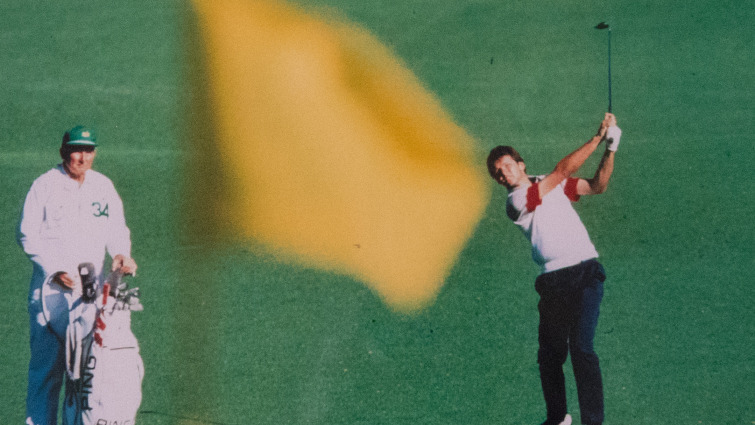 Scott Gump’s first appearance at the Masters came as an amateur in 1988. – Mike Bennett/Lighthouse Imaging
Scott Gump’s first appearance at the Masters came as an amateur in 1988. – Mike Bennett/Lighthouse Imaging
“Our (Notre Dame) guys played in 109 tournaments last summer. Nobody was there to tell them when to play their practice rounds, to see if they had enough tees in their bags. Do you have enough snacks, did you send in your entry form? What hotel are you staying in? How are you getting to your next event? Guys do everything themselves. They own their world. They know how to do things. We look for that in recruiting.
“Now, the downside is that at age 19 the reaction is, ‘I got it, coach. I’m fine.’ It’s all a confidence game.”
Despite all his professional experience, Gump has learned to pick his spots when it comes to offering advice to Irish players.
“I know the styles of techniques and the emotions. I am constantly preparing myself for when the opening comes. That’s when you can seize the moment. I can’t just be the talking adult spouting on about what I’ve seen.
“For these guys it’s their own personal experience. When they finish playing it’s not time for a pep talk – emotions are usually too high – they are not going to absorb it. They become more introspective a day and a half later – and that’s when I can do my coaching. They’re more open to it and the wounds are fresh.
“Hunter Ostrom (a freshman from Eagle, Idaho) has posted some outstanding scores in qualifying and is doing a grip change. That’s a big deal. It’s going to take some hard work, and we’ve got to address that.
“Davis Lamb (from Potomac, Maryland) just had his first top 10 (finish) as a freshman. He gutted out two five-foot putts on the last few holes. He stayed in his routine – he did not try to do too much or treat it as extra special. With that, it’s a matter of praising him – that’s how you win big events.
“John Felitto (a freshman from Mountainside, New Jersey) has shown some resiliency in tournaments this year. He won our opening warm-up event with a stellar 65 final round. A 65 at the Warren is an outstanding round.
“I have to be a chameleon based on what they need. Each player is in a different place. One guy who did not make the cut for a tournament is worried about technique. The guy who just finished in the top 10-let’s not celebrate that too hard, we gotta get ready for the next event.
“The real nuggets are about where their emotions are when they are out there. Golfers will tell you how they feel emotionally when you get them one on one and hold them accountable. It’s an emotional game-that’s why it’s so fun – and that’s why it’s great to tap into that as a coach.
“How can I reach these guys? They are lone wolves, they own it and there’s always a little stubbornness. My job is to work all around that. And then you have 10 or 11different personalities. It’s a blast, but sometimes it’s just flat-out hard.
“It’s really about them. They do not care what I’ve done. I want them to own it and have confidence. I can go back to my experiences and talk about when I played with Arnold Palmer. I can say, ‘Son, that was some nice swinging.’ But until they believe it and own it, it doesn’t matter what I say. Shouldn’t my words have value? In golf it’s different. It’s such a nervous confidence game.
“I had a guy shoot 68 and the next day shoot 83. You go from being in absolute control to ‘I do not even know how to tie my shoes.’ That’s why it’s such an emotional game. You go from thinking you own the game to ‘I’m a step slow today’ to ‘I tripped five times in a row.’ I respect that because I have tripped and fallen in front of lots of people.”
The biggest change in the game since Gump played regularly is ball-striking distance.
“I hit it 263.9 yards and was 69th in distance after year one – I was middle of the road,” he says. “The longest I hit it was 278. So I got older and gained 15 yards, but by then I was 10th from last-I lost 120 spots in distance. That’s the biggest difference.
“Last week I saw Sergio hit eight-iron into 15 at Augusta. I hit one-iron when I played as an amateur (in 1988). The distance off the tee totally changes the game.
“I’m in awe of Sergio hitting the proper distance. That’s an art that’s unbelievable. On 15 he flew that eight-iron the exact distance to the pin. How did he do that when he’s playing for history with that adrenaline? When those were not the conditions six days earlier when you were practicing and there was no adrenaline and no excitement?
“You become Superman out there-you hit the ball a lot farther. To pull the right club and know it? I’m in awe watching Sergio handle all those emotions and do it on Seve’s (Ballesteros) birthday.
“I’ll try to have those same conversations with guys on our team. ‘Hey, what did you see there? What did you think of how they handled that?'”
Gump is convinced that reading body language is the window into a golfer.
“I can tell from two holes away when somebody on our team has three-putted. Take one look at a guy and I know what happened. You can watch guys on tour playing in front of millions of people-after they make or miss a putt you see maybe a flash of anger, but by the time they walk off the green they have an even pace and they don’t feel broken. They are undeterred by a miss.
“Blake Barens (an Irish senior from Villa Park, California) shot 202, a great score, and won our home event (in October). When we watched him at the U.S. Amateur last summer-and he made it to the match play–what did he do? He did not get down on himself. You accept what happens and move on.
“He had some three-putts last week at Chambers Bay, and he gets down because he wants it so desperately. He really wants it. You put this on (the ND logo), it’s a big, big deal. And golf is such a confidence game that it can become too big a deal.
“I’ll looking at Blake and say, ‘Did you watch the Masters? Can you believe Adam Scott? Did you see him walk off the green after he missed that three-foot putt (at Augusta)?'”
Gump is convinced there’s something to learn around every corner of a golf course.
“That’s why I still love watching golf. I loved Augusta. On Sunday, what’s Sergio going to do?
“When he’s in the bush on 13, how’s he going to handle that? How’s his body language? Did he understand that he could still make par? And he did.”
This week Gump’s former pro colleagues are at the RBC Heritage event in Hilton Head Island, South Carolina.
Next week, while Notre Dame is competing at the ACC Championships, the PGA Tour moves to the Valero Texas Open in San Antonio.
If Gump can’t watch live he’ll lean on his trusty DVR.
Count on the 51-year-old Irish assistant to have picked up a few more tricks of the trade along the way.
Senior associate athletics director John Heisler has been covering the Notre Dame athletics scene since 1978. Watch for his weekly Sunday Brunch offerings on UND.com.







